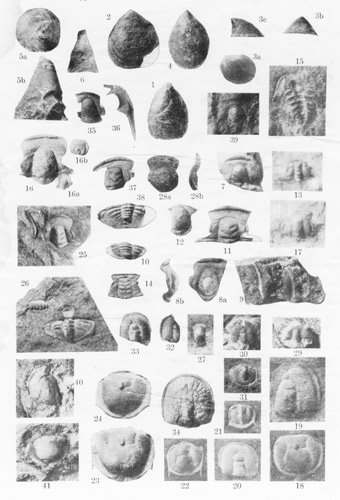
Natural Resources Canada > Earth Sciences Sector > Geological Survey of Canada > Past lives: Chronicles of Canadian Paleontology
Past lives: Chronicles of Canadian Paleontology The Japan connection

Teiichi Kobayashi, professor of paleontology at the Imperial University of Tokyo in the mid-1930s when he was working on Cambrian and Ordovician fossils from the McKay Group in the Columbia Valley. |
Archeologist, anthropologist,
biologist, geologist or paleontologist, European and North American
scientists have, frequently and with assumed privilege, published on
artifacts and natural history specimens collected (plundered?) from sites in
Asia. In paleontology, Teiichi Kobayashi is one of the few Asiatic scientist
who have turned the tables.
In the 1920s and '30s when
the Geological Survey of Canada began reconnaissance mapping of
the Cordillera, many of the field geologists complained bitterly
about the difficulty in getting accurate and speedy
identifications of fossils that were necessary to unravel the
complicated geology of these mountains. The Chief Geologist of
the GSC at the time, George A. Young, was no fan of paleontology
and, during his tenure, the Paleontological Division was kept
understaffed and underpaid. The few paleontologists were sent in
the field to do geological mapping instead of working with
fossils. Young derisively dismissed the value of fossils in
stratigraphy, "Damn it! A good field man can work out his
succession in the field without worrying about shells". So
when C.S. Evans began to accumulate numerous collections of
Cambrian and Ordovician fossils from shales and limestones of the
McKay Group during his mapping work in the mountains along the
Columbia River in eastern British Columbia, no GSC paleontologist
was assigned responsibility for identifying them. Help, however,
arrived from an unlikely source.
In the 1930s Teiichi Kobayashi
was a young paleontologist, bright and ambitious, at the Imperial
University of Tokyo who specialized on Lower Paleozoic fossils.
He was kept busy dealing with the Cambrian and Ordovician fossils
gathered by collectors who followed the Japanese imperial armies
as they invaded Korea and northern China. But Kobayashi was not
content to study Asian fossils only. He cast his eyes across the
Pacific and began to borrow collections of Lower Paleozoic
fossils from Argentina, Nevada, Alaska, Australia and British
Columbia -- including the entire fossil lot Evans had collected
from the McKay Group. GSC brass was delighted -- prompt work from
a paleontologist they didn't have to pay! Kobayashi
published his first paper on B.C. fossils in 1938. This dealt
with the Upper Cambrian trilobites of Mt. Jubilee just west of
Harrogate. A major monograph on Ordovician fossils of the McKay
was delayed by events such as Pearl Harbor and Hiroshima, and it
did not appear until 1955. The B.C. fossils spent the war years
in the basement of the Imperial University of Tokyo.

Upper Cambrian trilobites from the Columbia River Valley described by Kobayashi in 1938. |
Kobayashi's fossil
photographs are not particularly good and many of the trilobites
he studied are poorly preserved in shale. Nonetheless, his work
was important in that he demonstrated that most Late Cambrian and
Early Ordovician time was represented in the McKay Group. Until a
few years ago, his two papers were the only ones available on
trilobites from the McKay Group of eastern British Columbia --
both of them published in English in Japanese journals.
| 